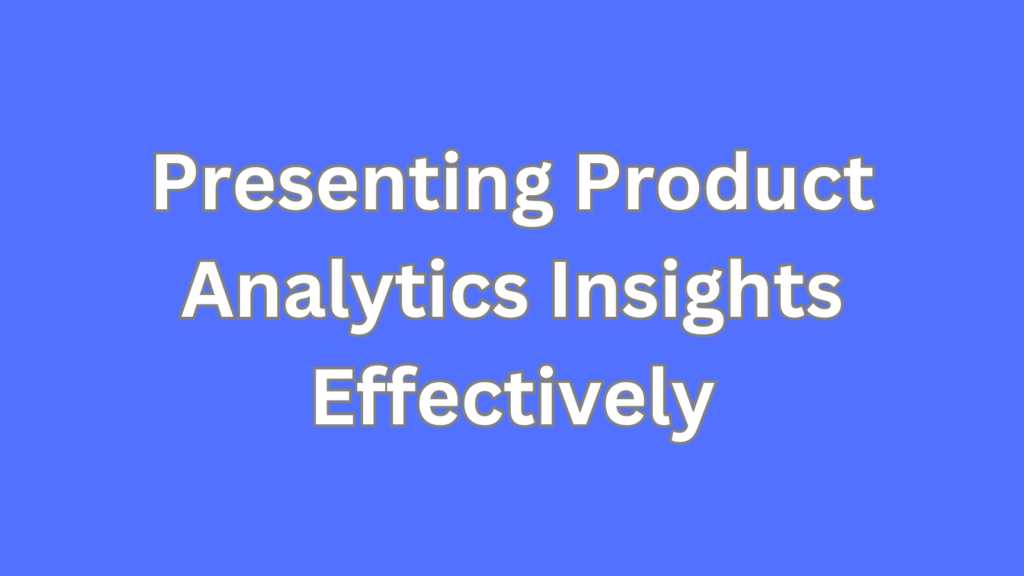Effectively presenting Product Analytics Insights is becoming a paramount skill for professionals across various industries. As organizations harness the power of data to inform strategic choices, the art of communicating these insights coherently becomes a critical determinant of success. In this comprehensive guide, we will embark on a journey through the intricacies of presenting Product Analytics Insights, providing a step-by-step process that not only demystifies the complexities of data but also empowers you to convey compelling and actionable insights to diverse stakeholders within your organization.
As the digital ecosystem continues to expand, the role of analytics in shaping product strategies, marketing initiatives, and overall business direction has never been more crucial. Whether you’re a data analyst, product manager, or a C-level executive, navigating the sea of data and presenting meaningful insights is a skill that can set you apart in today’s competitive landscape. This guide aims to equip you with the tools and methodologies needed to understand your data and artfully present it in a manner that resonates with your audience, fostering a culture of data-driven decision-making within your organization.
Step 1: Know Your Audience
Understanding your audience before diving into the intricacies of presenting Product Analytics Insights. Tailor your presentation style, depth, and technicality based on the stakeholders involved. Executives may prefer a high-level overview, while product managers may appreciate a more detailed analysis. Acknowledge your audience’s diverse needs and perspectives to ensure your insights resonate effectively.
Step 2: Craft a Clear Narrative
Building a cohesive narrative is key to presenting Product Analytics Insights successfully. Start with a concise overview of the problem or opportunity at hand. Clearly define your objectives and the questions your analytics seek to answer. Weave a storyline that guides your audience through the data journey, making it easy for them to follow and understand the insights presented.
Product Analytics Insights
Step 3: Visualize Data Effectively
Utilize visualizations to bring your Product Analytics Insights to life. Charts, graphs, and dashboards can simplify complex data sets, making it easier for your audience to grasp key trends and patterns. Choose visuals that align with your narrative and avoid clutter – simplicity often enhances comprehension. Ensure your visualizations are intuitive, and provide clear labels and annotations to aid interpretation.
Step 4: Provide Context
Contextualizing your Product Analytics Insights is crucial for a holistic understanding. Explain the background, highlight relevant industry trends, and elucidate any external factors influencing the data. By offering context, you empower your audience to make informed decisions based on a comprehensive understanding of the circumstances surrounding the insights presented.
Step 5: Highlight Key Findings
Clearly articulate the most significant Product Analytics Insights. Prioritize and emphasize key findings that directly align with your objectives. Whether it’s a notable increase in user engagement or a concerning drop in conversion rates, ensure that your audience can readily identify the pivotal takeaways from your analysis.
Step 6: Address Limitations and Uncertainties
Acknowledge the limitations and uncertainties inherent in any analysis. Be transparent about data gaps, potential biases, or external factors that could impact the reliability of your Product Analytics Insights. Providing this context builds trust with your audience and demonstrates a commitment to thorough and honest analysis.
Step 7: Relate Insights to Business Impact
Connect your Product Analytics Insights to tangible business impact. Translate data points into actionable recommendations that align with organizational goals. Whether optimizing user experience, refining marketing strategies, or enhancing product features, illustrate how the insights presented can drive positive outcomes for the business.
Step 8: Foster a Q&A Dialogue
Encourage a two-way dialogue by inviting questions and feedback. Be prepared to address queries regarding methodology, assumptions, or potential alternative interpretations of the data. This interactive approach ensures clarity and strengthens the team’s collaborative spirit, fostering a culture of continuous improvement.
Step 9: Create Actionable Next Steps
Cap off your presentation by outlining actionable next steps based on the Product Analytics Insights shared. Collaborate with your audience to define strategies and initiatives, leveraging insights to drive positive change. Establish a roadmap for implementation, setting realistic timelines and milestones for monitoring progress.
Effectively presenting Product Analytics Insights is an art that combines technical proficiency with effective communication. By understanding your audience, crafting a clear narrative, visualizing data, providing context, highlighting key findings, addressing limitations, relating insights to business impact, fostering dialogue, and creating actionable next steps, you can elevate the impact of your analytics within your organization. Presenting insights is not just about showcasing numbers; it’s about empowering your team to make informed decisions that drive continuous improvement and success.

